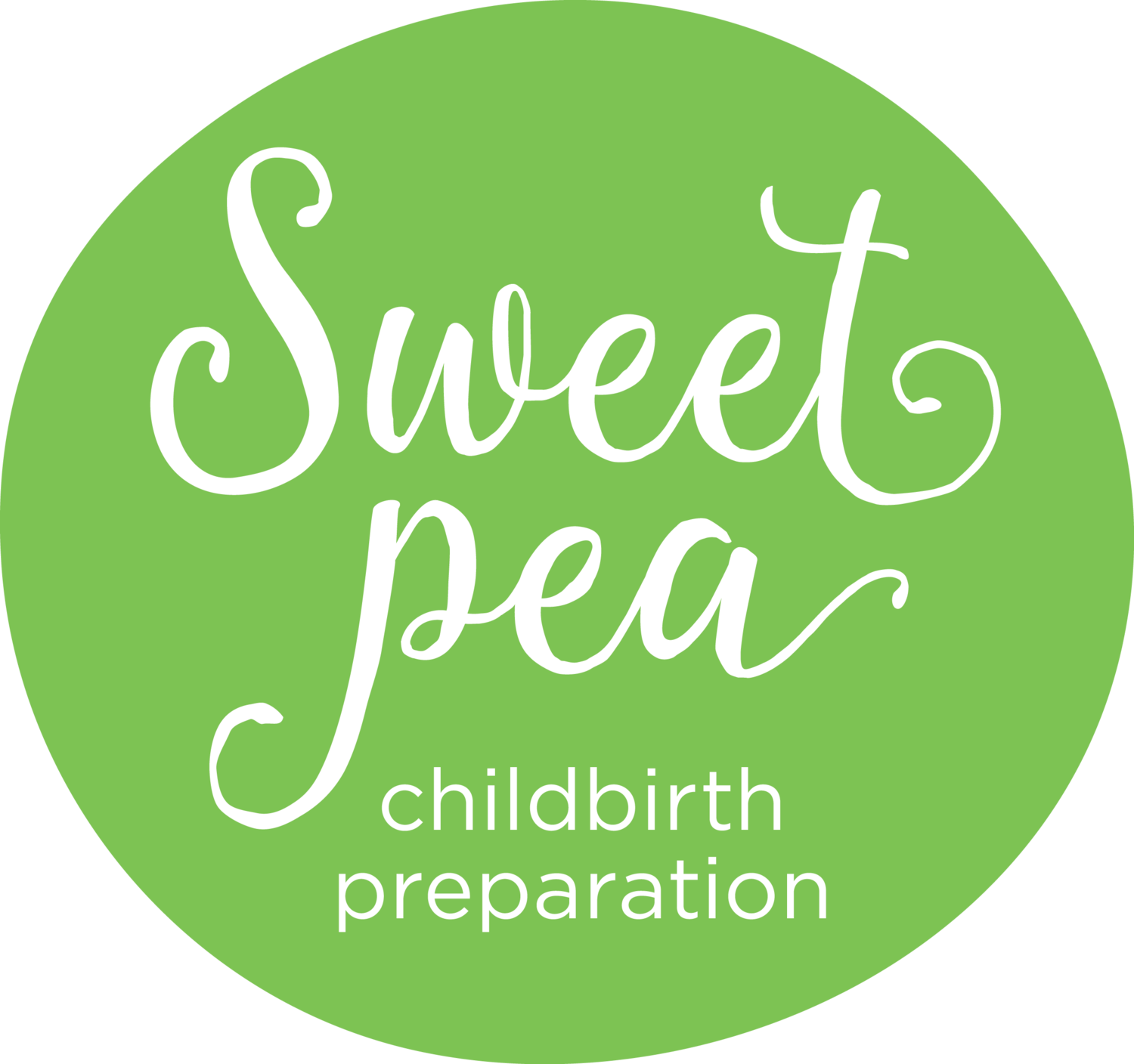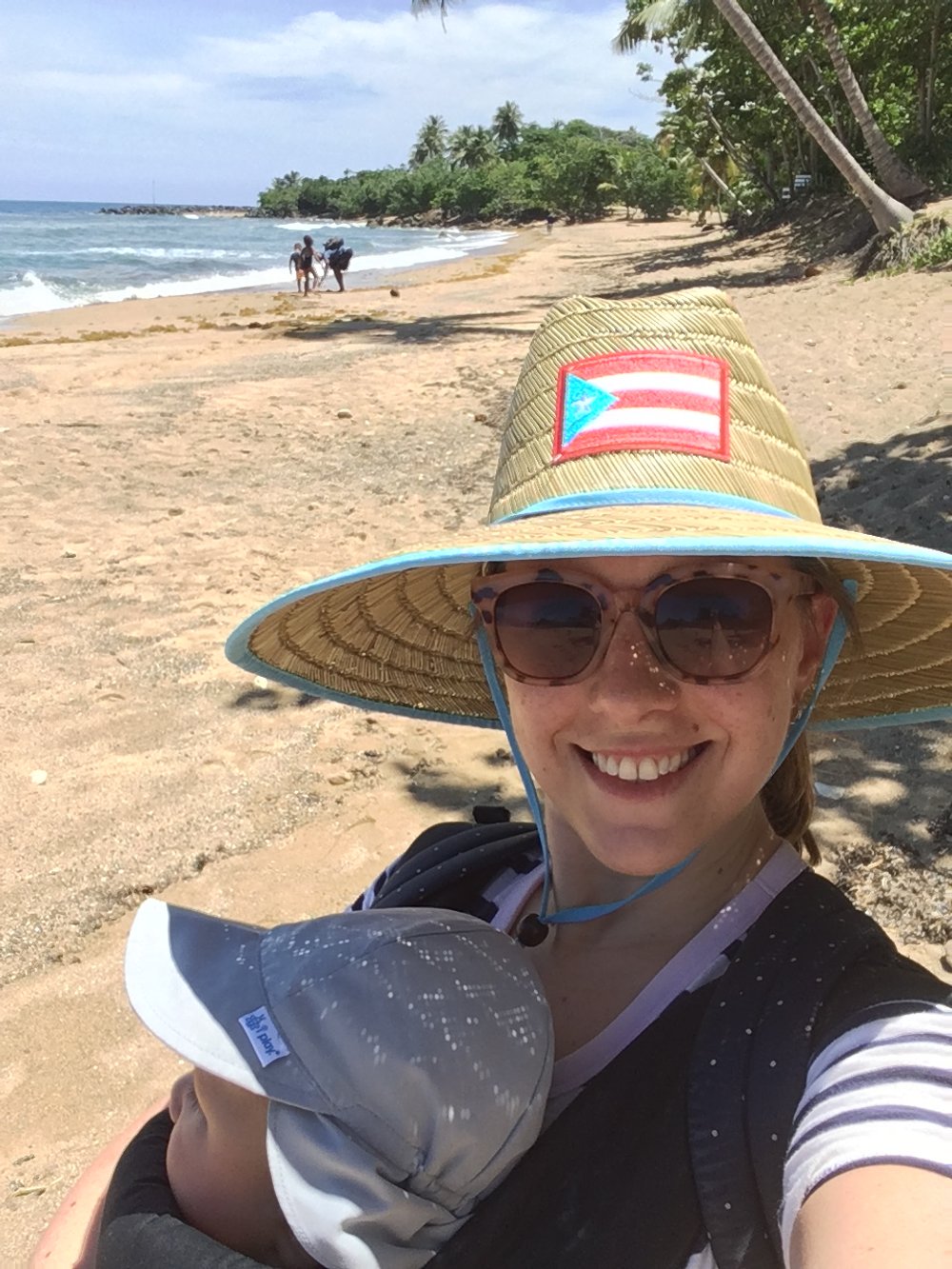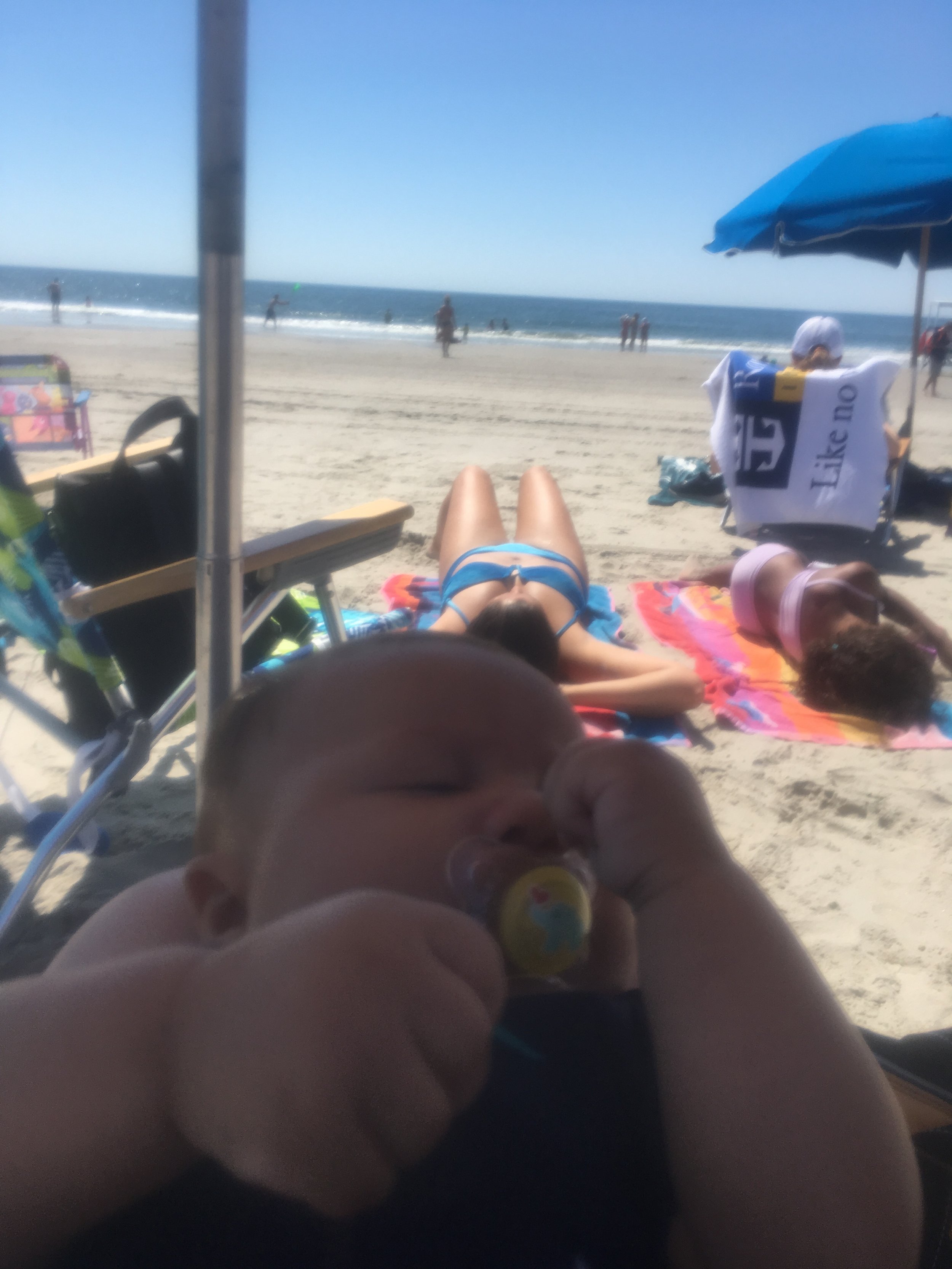Beach Time With A Baby: Safe Sunscreen Practices And How To Have (some) Fun!
/Leaving the house with a baby can feel daunting let alone taking your baby on a trip to the beach. New parents will get to their first summer with a new baby and wonder “can I take my baby to the beach?” Once you decide you are going to the beach the next question is, “what type of sunscreen is ok to use on my infant? As a new parent you often have so many supplies that you feel are required to get through a day with your baby and for many it seems like more effort than it's worth to plan a beach trip with a little one in tow. You’ve got the diapers, the wipes, the breastfeeding or bottle feeding supplies, the change of clothes, the sun hat, the umbrella, the chairs, the toys…and then there is the issue of the sand and if the baby will actually sleep on the beach. If you are planning a beach nap, where and how will that happen and does that mean you will need to bring even more supplies? After all of that effort, if it goes poorly and you can not make it work, are you going to pack up and go home? Phew… it all makes me tired to think about. Having a successful beach trip with a child under 1 is possible but you have to be thoughtful. Below are my tips for a (mostly) hassle free beach trip with a baby.
The American Academy Of Pediatrics Says To Keep Babies 6 months & Younger Out Of The Sun But Consider This…
The American Academy Of Pediatrics recommends keeping babies 6 months old or younger out of the sun. Some may interpret this as not going to places such as the beach/ocean/lake but really it just means being extra careful when bringing baby outdoors to both protect their skin, maintain their appropriate temperature and hydration. Truthfully, if you can keep a baby 3 months old or younger home I would encourage it. As you start to come out of those first three months however you will need to transition to living the life you want to live as a family and your baby is now a part of that. Spending time outdoors with your baby means shading from the sun, breathable fabrics for ventilation, ensuring proper storage and preparation of baby fluids/food, and shorter intervals spent outdoors. If you are venturing out into the world please check out my 4 tips below to consider as you prepare.
Tips For New Parents Headed To The Beach With Baby
Pack Light But Smart
Set Expectations
Educate Yourself (On sunscreen rules and risks)
Have Fun (Keep the stress level low)
4 month old Benji site seeing in Puerto Rico in his stroller. Dont forget the fan!!
The activity you are planning and the terrain may affect what supplies you use. For example, if you are going onto the sand I would NOT bring your stroller. While carrying a baby the whole time sounds tough, I promise rolling your stroller on the sand WHILE still carrying your baby the whole time is harder.
If you are site seeing however you may find that a stroller with a shade cover is perfect. Just don’t forget to keep the air moving as it can get hot under the shade covers. Try to plan your route so you can be prepared. Will there be steps? How long is the walk? Does the location have shade already or will you need to make it yourself?
First Tip: Pack Light But Smart
What I would bring in my beach backpack
Yes, I said backpack
Sun hat for mom/and baby
Carrier - to be worn. Mine is a Beco
Chair & Towel x 2 (and maybe an umbrella)
Baby Safe Sunscreen (see suggestions below)
Clean Water (for you to drink as well as sandy hands/eye emergencies)
A muslin swaddle blanket
Extra baby clothes
Diapers & Wipes
Backpack
I recommend that you pack all of your supplies for the beach in a backpack and NOT a tote bag or purse. A backpack keeps you balanced and hands free where a tote bag requires a shift in your weight to keep it on your shoulder or the use of your arms and hands. Stick with a backpack and remain comfortable and hands free.
Step One: Put your baby carrier on first
I like the Beco Carrier. I had other carriers but used this one the most. Its soft for the wearer and baby but structured. Truthfully it fits a woman’s hips/curves really well at the waist band. Its also sturdy. The Beco in this picture was literally 7 years old when I brought it on this trip.
Step Two: Put your backpack on second.
Putting on the backpack second will allow you to remove and access your backpack without disturbing your baby. Need to get your keys out or a sip of water? No problem, slide off your backpack and simply use your hands while carrying the baby on your front side.
Step Three: Wear a wide brimmed hat
A wide brimmed hat provides you with shade but will shade your baby as well. Limiting your small baby's sun exposure is important but hard to do. Instead of forcing your baby to stay under an umbrella, bring the shade to your baby so you can stay on the move. Your wide brimmed hat will shade your baby in your front wear carrier.
Step Four: Consider baby’s clothing and use your muslin swaddle in new ways
You will want to dress your baby appropriately. You can use clothes to shield your baby from the sun but if you do be sure to pick breathable fabrics. If it is very hot outside you could put your baby in a onesie and use your muslin swaddle blanket as a shade. Muslin is a breathable cotton that serves so many purposes, one of which being a sun shade. While your baby is in your carrier try tucking one corner of the swaddle blanket under each shoulder strap of your carrier. Leave the blanket open on the sides/bottom and let it hang down over your baby’s body and legs. You can also use your muslin as a sun shield in a variety of other settings such as over a car seat or stroller, just be sure that there is proper ventilation and air flow to your baby. Leave your breastfeeding cover at home… just use the muslin blanket if you want to cover up.
Step Five: Take A Seat
Once you get where you are going you will need somewhere to sit which may be a beach chair or a towel depending on your location and abilities. You will also need a towel that you can keep sand free for a diaper change or to lay your baby down as needed. Pick thinner towels that fit more easily in your backpack. Since your hands are free with baby on the front and a backpack on your back now you can carry a small chair in one arm! Viola!
I love sitting under an umbrella but this often feels like a luxury unless you have some extra help or a kind friend who can help. It is possible however to find a small beach umbrella that could provide shade over a smaller area and also be light enough to carry. Look for something light weight as well.
Second Tip: Set Expectations
Benji literally napping on my legs. Not exactly footloose and fancy free… but I was having a nice time regardless.
Maybe you are a beach lover or maybe you just go to the beach occasionally. Either way if this is your first beach trip with a baby it will be different than your trips of the past. Expectations do not necessarily have to be lower, just different.
I suggest that you plan to be out for a shorter time at the beach than you might normally if you were flying solo. Don’t be shy and also be sure to take that friend offering to hold the baby up on that offer. While the above tips will help you feel more capable and successful you are never really free while at the beach with a baby so do not let it get you down.
You may be spending a bit more time than you are used to in the shade or with a human strapped to your body but that does not mean you can't enjoy your favorite beverage while sitting there, your favorite tunes or podcast while baby sleeps on your chest, or the company of your beach companions. .
Third Tip: Sunscreen Safety
Sunscreen safety for the littlest beach goers is a common question. You do not want them to get too much sun but it is also advised not to use sunscreen on babies under 6 months old. So what are you supposed to do? The truth is that babies younger than 6 months old run the risk of absorbing too much of the chemicals in sunscreen. The goal then becomes doing what you can to avoid sun and using a minimal amount of safe sunscreen as needed.
Here is what the FDA recommends:
Here are some things to keep in mind this summer when outside with infants younger than 6 months:
Keep your baby in the shade as much as possible.
Talk to your pediatrician before using any sunscreen on your baby.
Make sure your child wears clothing that covers and protects his or her sensitive skin. If you hold the fabric against your hand and it’s sheer enough to see through it, it probably doesn’t offer enough protection.
Make sure your baby wears a hat that provides shade to the face, neck, and ears.
Watch your baby carefully for warning signs of sunburn or dehydration. These signs include fussiness, redness, and excessive crying.
If your baby is becoming sunburned, get out of the sun right away and apply cold compresses to the affected areas. Call your baby’s pediatrician right away.
Hydrate! Give your child formula or breast milk if you’re out in the sun for more than a few minutes.
Remember to pack a cooler to store the liquids.
Below are some tips from the American Academy of Pediatrics.
Clothes and hats can protect skin – whenever possible, dress yourself and your children in cool, comfortable clothing that covers the body, such as lightweight cotton pants, long-sleeved shirts, and hats.
Select clothes made with a tight weave; they protect better than clothes with a looser weave. If you’re not sure how tight a fabric’s weave is, hold it up to see how much light shines through. The less light, the better. Or you can look for protective clothing labeled with an Ultraviolet Protection Factor (UPF).
Wear a hat with an all-around 3-inch brim to shield the face, ears, and back of the neck.
Try to limit your sun exposure between 10:00 am and 4:00 pm when UV rays are strongest.
Wear sunglasses with at least 99% UV protection. Look for youth-sized sunglasses with UV protection for your child.
Seek shade for your activities whenever you can.
Use sunscreen. Choose a sunscreen that says “broad-spectrum” on the label; that means it will screen out both UVB and UVA rays.
If possible, choose a sunscreen with the mineral ingredients zinc oxide or titanium dioxide. If you can’t find a product with these ingredients, remember that using any sunscreen is better than using none. We don’t want anyone to sunburn since sunburning raises the risk of developing skin cancer later in life.
Use a broad-spectrum sunscreen with a sun protection factor (SPF) of at least 15 (up to SPF 50). An SPF of 15 or 30 should be fine for most people. Research studies are underway to test if sunscreen with more than an SPF of 50 offers any extra protection.
Apply sunscreen to parts of your child’s skin that may be exposed to the sun, even on cloudy days because the sun’s rays can penetrate through clouds. Make sure to use enough sunscreen. Reapply every 2 hours when outside, and after swimming and sweating.
Keep babies younger than 6 months out of direct sunlight. Find shade under a tree, an umbrella, or the stroller canopy. If it’s not possible to find shade, sunscreen may be applied to babies younger than 6 months to small areas of skin that are not covered by clothing and hats – this is because we don’t want babies to sunburn.
Make sure everyone in your family knows how to protect their skin and eyes. Remember to set a good example by practicing sun safety yourself.
Sunscreens To Try:
Beautycounter
When you want to put a bit of sunscreen on your baby or you are breastfeeding and wondering what to use on your skin that is safe check out the Beauty Counter options HERE. They have a lengthy list of chemicals they avoid.
WhatToExpect.Com’s take on the top Type of Baby Sunscreens
What To Expect Online chose favorites based on “the recommendations from the doctors above [in their article], as well as those listed by AAP, to help choose sunscreens that are safe for babies. We also took into account sunscreen that members of the What to Expect community, as well as our editors, have tried and used for their own babies.”
Here Are Their Faves:
Best Overall: Think Baby SPF 50
Best Water-Resistant Baby Sunscreen: California Baby Super Sensitive Broad Spectrum SPF 30
And a few more highlighted for ease of application.
A sunscreen stick for the face and a lightweight or more easily absorbed option always is nice as it means less rubbing on your baby’s new skin.
Fourth Tip: Have Fun- Babies Feed Off Your Energy
It is easy to feel overwhelmed and wonder why you did this to yourself but its also important to be proud of the work you put in. My trip to Puerto Rico with a 4 month old or my first time bringing three children to the pool alone were some of my most bad ass mom moments. I have a neighborhood mom who still talks about seeing me for the first time at the pool with a baby strapped to my body and thinking “Wow!” And my point is not that I am a superhero… its that all moms are super heroes! I was lucky to have someone coach me up and now I am passing on the knowledge.
Your baby is watching and learning. If you are worked up and flustered, they will be as well. So take a deep breath and try to celebrate the small wins. That being said I still mourn the loss of my summer life without children. Closing my eyes and listening to the waves is not an option for fear of one of my kids thinking they are Michael Phelps and not the bowling ball they are (I borrowed that dad joke from my husband… thanks Trey). Watching my kids enjoying my favorite summer activities however is a new kind of joy.












